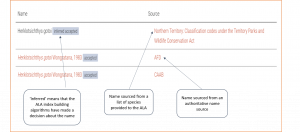Two improvements to the ALA’s naming and taxonomy index within the BIE (Biodiversity Information Explorer) have just been released. The BIE is the taxonomic backbone of the ALA, underpinning information for over 120,000 species.
1. All sources of name and taxonomic information are now visible
Data in the BIE is aggregated from many sources across Australia and New Zealand, such as the Australian Faunal Directory (AFD) or the New Zealand Organisms Register. Government agencies also supply names. Before now, only one data source was listed per taxonomic concept (this term refers to the scientific name plus the position of that species in the tree of life). Our recent update allows multiple sources to be listed. Users can now see all sources and click through to more information about the taxonomic concept from each data source. Name and taxonomic information is available on the ‘Names’ and ‘Classification’ tabs on ALA species pages.

2. Introduction of ‘inferred’, ‘inferred synonym’ and ‘inferred accepted’
In order to manage taxonomic information in the ALA, we select and consult authorities in particular areas. For example, the Australian Plant Census is regarded as authoritative for plants, except for mosses, where AusMoss (Catalogue of Australian mosses) takes precedence. We use other taxonomic lists to fill in gaps. The result is a combined taxonomy.
Sometimes, the algorithms that the ALA uses to build the combined taxonomy have to make a choice about how to deal with contradictory or missing information. These decisions are marked by the word ‘inferred’. The use of ‘inferred’ allows ALA users to clearly see whether the taxonomic description is from an authoritative source or from the ALA algorithms.
Sometimes, two sources disagree about where a name appears in the taxonomic tree. When this happens, the ALA chooses one primary taxon based on the relative authority of the sources, and makes the other names ‘inferred synonyms’ to the primary taxon.
In some cases, not much is known about a name either because it comes from incomplete data or because the source knows about the name but has not yet placed it in its taxonomy. The ALA assigns ‘inferred accepted’ to a name that is assumed to be accepted and, from the information available, makes a best effort at placing the name in the taxonomy.
The ALA is able to respond to changes in taxonomy and works closely with taxonomic directories to keep the ALA species lists up-to-date. We thank the following directories for their ongoing support and expertise: the Australian Plant Name Index (APNI), Australian Plant Census (APC), the Australian Faunal Directory (AFD), the Australian Biological Resources Study (ABRS), Australian Fungi, Australian Mosses Online, Australian Codes of Aquatic Biota, Catalogue of Life, and the New Zealand Organisms Register.
Please contact us if you have any questions.